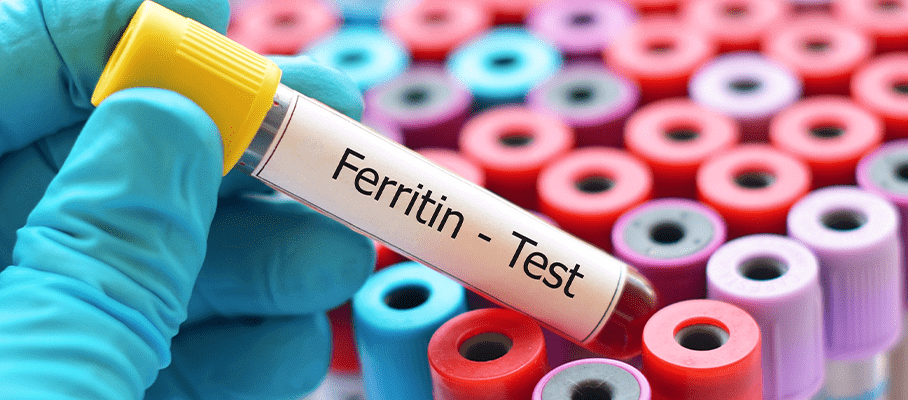Disease
Ferritin Test: Purpose and Making Sense of Results
15077 Views
0

Ferritin test is a type of blood test that measures ferritin level in the blood and provides important information about a person's iron levels and overall health.
What is Ferritin?
Ferritin is an intracellular protein present in most tissues which plays an important role in the storage of intracellular iron, however being a subject of extensive research recently, various other roles have also been ascribed to it.
Ferritin is produced by the liver and is stored in cells throughout the body, including in the liver, spleen, bone marrow, and muscle tissue. It is released into the bloodstream as needed to provide iron to the body.
This protein plays a crucial role in the body's oxygen transport system as iron is a component of haemoglobin - the protein in red blood cells that carries oxygen to the body's tissues. Low levels of ferritin can lead to iron deficiency anaemia, a condition in which the body does not have enough red blood cells to deliver oxygen to the body's tissues.
Testing for ferritin is integral to evaluate a person's iron status and can help diagnose and monitor conditions such as iron deficiency anaemia.
How Does Ferritin Help?
The serum ferritin is an indirect measure of the total body iron stores and makes a very effective iron delivery system.
Ferritin test is a valuable tool for the clinician, both for evaluation of iron-deficiency anemia, and also for evaluation of iron-overload conditions, such as hereditary hemochromatosis and chronic transfusion therapy.
Factors That Can Affect Ferritin Levels
Ferritin levels can be affected by a variety of factors, including:
- Age: Ferritin levels typically decline with age, especially in older men.
- Gender: Ferritin levels are generally higher in men than in women due in part to the difference in body size and muscle mass between the sexes.
- Diet: A diet low in iron can lead to low ferritin levels. In addition, certain substances in the diet, such as tannins in tea and coffee, can interfere with iron absorption.
- Alcohol consumption: Excessive alcohol consumption can lead to low ferritin levels due to poor nutrition and damage to the liver, which is responsible for producing ferritin.
- Certain medications: Some medications, such as nonsteroidal anti-inflammatory drugs (NSAIDs) and corticosteroids, can interfere with iron absorption and lead to low ferritin levels.
These factors can affect ferritin levels independently or in combination, and it is crucial to discuss any concerns about ferritin levels with a healthcare provider.
Reasons to Test for Ferritin
There are several reasons why a healthcare provider may recommend testing for ferritin:
- To diagnose iron deficiency anaemia
- To monitor treatment for iron deficiency anaemia
- To evaluate the cause of abnormal ferritin levels
How Ferritin is Tested
Ferritin is typically tested using a blood test, which measures the level of this protein in the blood. The test is usually done in a healthcare provider's office or at a laboratory and involves taking a small sample of blood from a vein in the arm using a needle. Other tests that may be done in conjunction with a ferritin test include:
- Haemoglobin test: This test measures the level of haemoglobin. A low haemoglobin level can indicate anaemia, including iron deficiency anaemia.
- Complete blood count (CBC): This test measures the number and types of cells in the blood, including red blood cells, white blood cells, and platelets. A CBC can help to diagnose anaemia and determine the cause of anaemia.
- Iron studies: Iron studies are a group of tests that measure the level of iron in the body and the body's ability to use iron. These tests may include measuring the iron level in the blood, the transferrin saturation (the amount of iron bound to a protein called transferrin), and the total iron-binding capacity (the amount of iron that can be bound to transferrin).
It is vital to note that ferritin levels can be affected by other factors, such as inflammation and certain medications, and may not always accurately reflect the body's iron status. Therefore, ferritin testing should be combined with other tests to evaluate a person's iron status.
Ferritin Test: Making Sense of the Results
The normal range for ferritin levels in the blood may vary depending on the laboratory, but generally, normal ferritin levels are considered to be:
- For men: 30-400 ng/mL
- For women: 12-150 ng/mL
- For children: 12-120 ng/mL
Ferritin Test for Iron levels
Ferritin serum test is usually a part of a panel of several blood tests routinely ordered to diagnose and manage iron deficiency anemia. If a ferritin test indicates that your level is lower than normal ferritin levels, it indicates your body's iron stores are low and you may have iron deficiency. You could be anemic. However as normal ferritin levels change according to various physiological and pathological conditions, its values must be judged with caution.
Low serum ferritin is highly specific for iron deficiency anemia, and is much more convenient than the gold standard method of obtaining a bone marrow biopsy to assess stainable iron. Ferritin normal range varies across laboratories, but levels of 30 to 300 ng/ml are considered normal for men, and 10–200 ng/ml for women. Studies suggested that a level higher than approximately 40 ng/ml should be used to exclude iron deficiency in most patients, whereas a level higher than 70 ng/ml is more appropriate to exclude iron deficiency in patients with inflammation or liver disease where serum ferritin levels are raised as a nonspecific marker of illness.
Common Iron Deficiency Anemia Symptoms to Look for:
Iron deficiency anaemia is a common condition that occurs when the body does not have enough iron to produce enough red blood cells. It can be caused by various factors, including inadequate intake of iron in the diet, blood loss (such as due to heavy periods or gastrointestinal bleeding), and poor absorption of iron from the digestive tract.
It is important to note that these symptoms can also be caused by other conditions, and a diagnosis of iron deficiency anaemia should be confirmed through laboratory testing.
- Fatigue: Iron deficiency anaemia can cause fatigue due to the lack of oxygen delivered to the body's tissues.
- Weakness: Iron deficiency anaemia can cause weakness due to the lack of oxygen delivered to the muscles.
- Headaches: Iron deficiency anaemia can cause headaches due to the lack of oxygen delivered to the brain.
- Pale skin: Iron deficiency anaemia can cause pale skin due to the lack of oxygen delivered to the skin and the reduced number of red blood cells in the body.
- Running out of breath when doing even easy daily tasks like walking, climbing stairs, or working out.
- Irregular heartbeats
- Dry mouth or a swollen, inflamed, pale, or strangely smooth tongue.
Ferritin Test in COVID
Ferritin test, in the light of COVID-19 pandemic, has also emerged as an important diagnostic marker. As a mediator of cytokine storm, a form of extreme immune dysregulation associated with fatal outcomes, it is usually ordered as a part of a panel along with other inflammatory markers like ESR, CRP, D dimer and IL-10. Many studies have correlated high ferritin levels with severe COVID disease. In a small study with 20 people with COVID-19, it was found that individuals with severe and very severe COVID-19 exhibited increased serum ferritin level. However, your doctor is the guide here, always follow diagnostic and treatment related guidelines advised to you.
Ferritin Test for kidney Conditions
In patients with chronic kidney disease serum ferritin is a less robust marker of bioavailable iron. Although most patients on maintenance haemodialysis have a serum ferritin >500 ng/ml, this level does not represent the bioavailable iron and guidelines propose a serum ferritin level of 800 ng/ml as an upper limit for intravenous iron therapy whereas absolute iron deficiency is defined using another laboratory measure (transferrin saturation <20%) or serum ferritin <100 ng/ml.
Other Conditions
Serum ferritin has been shown to predict the risk of cirrhosis, in patients with hemochromatosis. The risk is extremely low for patients with serum ferritin levels less than 1000 micrograms/litre.
Elevated serum ferritin also predicts end-organ involvement in iron overload conditions, such as transfusion-associated iron overload in myelodysplastic syndromes, thalassemia and hemoglobinopathies. Levels less than 1500 ng/ml indicated mostly acceptable iron overload; levels greater than or equal to 3000 ng/ml were specific for significant iron-overload and were associated with liver injury. (Accurate assessment of iron levels is required in those with levels between 1500 and 3000 ng/ml.).
Serum ferritin levels may also be raised in many malignancies like neuroblastoma and breast cancer. Exact reason is however unknown but studies suggest that ferritin is merely being a serum maker and does not contribute to cancer etiology.
Book your test with us, know the ferritin test cost and access results from the ease of your home.
IMPORTANT TO NOTE
Always get your results interpreted through a medical professional. Test results may need to be evaluated alongside the clinical symptoms and can require other lab tests as well.























 WhatsApp
WhatsApp